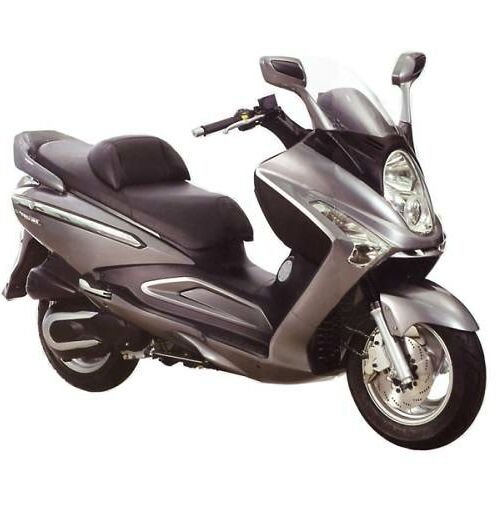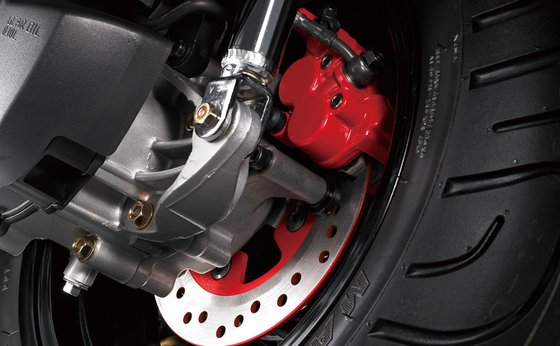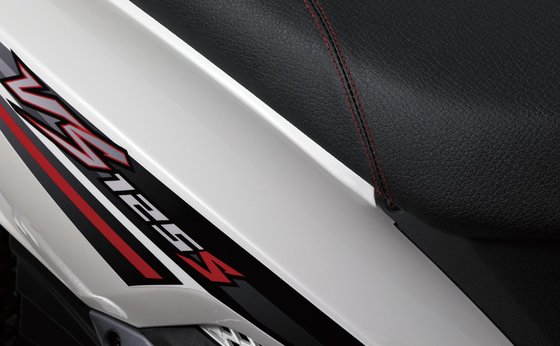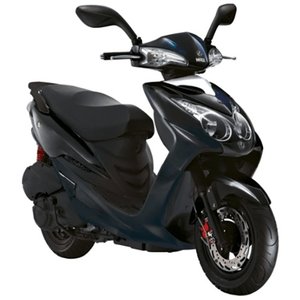SYM VS 125 [2006-2015] Review: A Commuter’s Reliable Companion

Introduction
The SYM VS 125, produced between 2006 and 2015, stands as a testament to practicality in the 125cc scooter segment. Designed for urban commuters who value simplicity and efficiency, this Taiwanese-built workhorse carved out a loyal following across Europe, Asia, and beyond. While it won’t set your pulse racing with raw power, it delivers exactly what it promises: dependable transportation with a focus on low-cost ownership. After spending a week weaving through city traffic and tackling suburban errands, it’s clear why this scooter remains a common sight on roads even years after its discontinuation.
Design & Ergonomics

The VS 125’s design is a masterclass in no-nonsense functionality. Its underbone steel frame gives it a slightly bulkier profile compared to ultra-slim rivals, but this translates into surprising stability at higher speeds. The body panels—available in classic colors like Black, White, Blue, and Silver—are durable but not flashy, with clean lines that age gracefully.
At 780 mm (30.7 inches), the seat height accommodates riders of most statures, and the wide, lightly padded seat feels forgiving even after an hour in the saddle. The floorboard is spacious enough for a medium-sized grocery bag, and the 130 mm (5.1 inches) ground clearance handles curbs without scraping. SYM kept the weight manageable at 132 kg (291 lbs), making it easy to maneuver in parking lots despite its 1,935 mm (76.2-inch) length.
The analog instrument cluster is basic but legible, featuring a speedometer, fuel gauge, and odometer. The switchgear feels robust, though the lack of a fuel-injection warning light (common in carbureted models) might confuse newer riders during cold starts.
Engine & Performance

Powering the VS 125 is a 124.6 cc air-cooled single-cylinder engine with a CV carburetor—a setup that prioritizes reliability over cutting-edge tech. With 11.4 HP @ 8,250 rpm and 10.6 Nm (7.82 lb-ft) of torque peaking at 6,500 rpm, acceleration is leisurely but adequate for city use. The CVT transmission ensures smooth power delivery, though steep hills will require patience: The scooter’s 28° climbing ability feels optimistic when tackling gradients with a passenger.
Top speed is a governed 100 km/h (62 mph), achievable only under ideal conditions. Realistically, expect 85–90 km/h (53–56 mph) on flat roads—enough for urban highways but not for overtaking. Where this engine shines is fuel efficiency. SYM claims 1.9 L/100 km (122 US mpg), and in mixed riding, I averaged 2.2 L/100 km (107 mpg). The 5.5 L (1.45 US gal) tank grants a 250 km (155 mi) range, perfect for weekly commutes.
Cold starts can be finicky due to the carburetor, especially in temperatures below 10°C (50°F). The dual electric/kick starter ensures you’re never stranded, but upgrading to an iridium spark plug (like the NGK CR7EIX listed in SYM’s specs) improves cold-weather reliability.
Handling & Ride Experience
The VS 125’s handling is where it punches above its weight class. The telescopic front fork and preload-adjustable rear shock absorb potholes competently, though sharper bumps can jolt through the chassis. The 12-inch wheels—wrapped in 110/80 front and 130/70 rear tires—strike a good balance between agility and stability.
Braking is adequate but not inspiring. Earlier models used a 273 mm front disc paired with a rear drum, while later variants switched to a 130 mm rear disc. Even with the disc setup, braking distances are long compared to modern ABS-equipped scooters. Riders should prioritize replacing stock brake pads with high-friction alternatives for sharper response.
At low speeds, the VS 125 feels nimble, with a tight 52.9-inch wheelbase allowing U-turns in just two lanes. Wind protection is minimal, so sustained 80 km/h (50 mph) rides on open roads become tiring. This is strictly an urban tool.
Features & Practicality
SYM kept features simple to maintain affordability. The under-seat storage fits a full-face helmet (barely), and the optional rear rack expands cargo capacity. The 35W halogen headlights are underwhelming by modern standards—a common pain point owners rectify with LED upgrades.
The lack of a fuel gauge (only a warning light) and USB charging port shows its age, but the scooter’s simplicity means fewer components to fail. The belt-driven CVT requires minimal maintenance, though checking for wear every 10,000 km (6,200 mi) is wise.
Competition
The 125cc commuter scooter market is fiercely competitive. Here’s how the SYM VS 125 stacks up:
- Honda SH125: Honda’s premium offering boasts liquid cooling, fuel injection, and superior build quality. However, it’s significantly pricier, and its complex engine is costlier to maintain.
- Yamaha NMAX 125: A more modern rival with ABS and a peppy liquid-cooled engine. The NMAX feels sportier but sacrifices the SYM’s mechanical simplicity.
- Kymco Agility 125: Closest in spirit to the VS 125, with similar specs and pricing. The Kymco edges ahead in storage space but trails in seat comfort.
The VS 125’s strongest selling point is its accessibility. While rivals offer more tech, SYM’s scooter appeals to riders who prioritize ease of repair and lower ownership costs.
Maintenance
The SYM VS 125 thrives on neglect but rewards diligent care. Key considerations:
- Oil Changes: Use SAE 10W-40 oil (800 ml with filter changes). SYM recommends API SH-grade oil, which MOTOPARTS.store stocks for under €15/liter.
- Belt & Rollers: Inspect the CVT belt every 8,000 km (5,000 mi). Worn rollers cause sluggish acceleration—replace them with OEM or aftermarket kits.
- Brake Upgrades: Swap stock brake pads for sintered variants to improve stopping power. DOT 4 fluid should be flushed every two years.
- Tire Pressures: Maintain 1.75 bar (25 psi) front and 2.0–2.25 bar (29–33 psi) rear for optimal grip and tire life.
Common wear items like NGK CR7E spark plugs and air filters are affordable and easy to source. For riders in colder climates, installing a higher-output battery (compatible with the 12V 8.6Ah system) prevents cold-start issues.
Final Thoughts
The SYM VS 125 won’t dazzle you with innovation, but it excels as a fuss-free daily rider. Its carbureted engine and cable-operated brakes feel dated next to modern scooters, yet these “flaws” make it a favorite among DIY enthusiasts. For commuters seeking a reliable machine that won’t bleed their wallet dry, the VS 125 remains a compelling choice—especially when paired with strategic upgrades from MOTOPARTS.store.
Whether you’re refreshing an older model or maintaining a well-loved example, this scooter proves that sometimes, simplicity is the ultimate sophistication.
Specifications sheet
| Engine | |
|---|---|
| Stroke: | Four-stroke |
| Max power: | 8 kW | 11.0 hp |
| Max torque: | 11 Nm |
| Fuel system: | Carburetor (CV) |
| Lubrication: | Dry sump |
| Max power @: | 8250 rpm |
| Displacement: | 125 ccm |
| Max torque @: | 6500 rpm |
| Configuration: | Single |
| Cooling system: | Air-cooled |
| Compression ratio: | 11.2:1 |
| Number of cylinders: | 1 |
| Valves per cylinder: | 4 |
| Additional | |
|---|---|
| Battery: | 12V 8.6 Ah |
| Top speed: | 100 km/h (62 mph) |
| Color options: | Black, White, Blue, Silver, Red |
| Fuel consumption: | 1.9 L/100 km (52 km/L) |
| Climbing capacity: | 28° |
| Dimensions | |
|---|---|
| Wheelbase: | 1345 mm (53.0 in) |
| Dry weight: | 133 |
| Wet weight: | 132 |
| Seat height: | 780 mm (30.7 in) |
| Overall width: | 680 mm (26.8 in) |
| Overall height: | 1130 mm (44.5 in) |
| Overall length: | 1935 mm (76.2 in) |
| Ground clearance: | 130 mm (5.1 in) |
| Fuel tank capacity: | 6.0 L (1.59 US gal) |
| Drivetrain | |
|---|---|
| Final drive: | belt |
| Transmission: | CVT |
| Maintainance | |
|---|---|
| Rear tire: | 130/70-12 |
| Engine oil: | 10W40 |
| Front tire: | 110/80-12 |
| Break fluid: | DOT 4 |
| Spark plugs: | NGK CR7E or NGK CR7EIX |
| Spark plug gap: | 0.7 |
| Engine oil capacity: | 1.05 |
| Final drive oil capacity: | 100 ml 85W-140 |
| Transmission oil capacity: | 0.11 |
| Engine oil change interval: | Every 5000 km or 2 years |
| Valve clearance (intake, cold): | 0.10–0.20 mm |
| Valve clearance (exhaust, cold): | 0.20–0.30 mm |
| Recommended tire pressure (rear): | 2.0 bar (29 psi) solo, 2.25 bar (32.7 psi) with passenger |
| Recommended tire pressure (front): | 1.75 bar (25.4 psi) |
| Chassis and Suspension | |
|---|---|
| Frame: | Steel monocque split steel tube |
| Rear brakes: | 130 mm drum (non-asbestos lining) |
| Front brakes: | Single 273 mm disc, hydraulic |
| Rear suspension: | Single hydraulic shock absorber, adjustable preload |
| Front suspension: | Telescopic fork |
| Rear wheel travel: | Not specified |
| Front wheel travel: | Not specified |



















